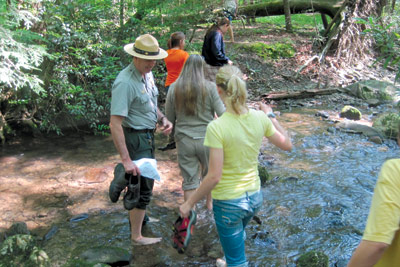I'm a volunteer at the Oconaluftee Visitor Center in the Great Smoky Mountains National Park, and I recently joined seasonal rangers for interpretive training. In National Park Service lingo, “interpretation” means enabling each visitor to personally connect with a place. We do this informally when we talk to them in the visitor center or on the trail, and formally when we present a program. Right now, I’m dividing my time between working behind the desk and roving the trails in uniform.

Passionate idealism
According to Cades Cove interpretive ranger Mike Meldrum, visitor contact is highly personalized. An interpreter must be able to evaluate the person and use a well-crafted response that’s most likely to get through to them. "You need to be committed and passionate," says Meldrum.
The National Park Service has even developed a “Visitors Bill of Rights.” "Visitors,” he notes, “are always watching you. So if you have a uniform, be careful: You're onstage." All this emphasis on service can spoil you for real life — like expecting supermarket checkout clerks not to talk to each other and concentrate on the customer instead.
The concept of stewardship, “to preserve and protect for future generations,” is holy. We need to make visitors feel that the park’s resources — mountains, trout and cabins — are theirs. Visitors will then experience a deep connection to the park and thus want to preserve it. It’s really a pretty optimistic view of the world: If you educate visitors, they’ll be inspired to protect the parks and so won’t litter, harass a bear or carve their names into a cabin.
The dance of history
Before the Smokies became a national park, the area was home to more than 200 communities. To communicate that, interpreters present programs in costume. We walked to the Ownby Cabin on a nature trail at the back of Sugarlands Visitor Center. Dressed as Mary Ownby (who lived there more than a century ago), Ranger Lisa Free was weaving a basket.
We were supposed to find problems with her presentation. Some were pretty easy to spot: a plastic water bottle close by, Free’s modern sneakers and plastic-handled scissors and screwdriver. Other inconsistencies were less obvious: Free’s sleeves rolled up above her elbows (which modest women don't show).
Free started out playing the character, which isn’t done much in the Smokies: It makes it tough to answer visitor questions when the interpreter can't break character. Instead, Free quickly switched to third person so she could talk about the owners of the house and their times. It's also easier to interact with visitors that way.
In the trenches
Some visitors come to the Smokies without any preparation and ask, "What can we do around here?"
"Well," I point out, "there are over 800 miles of well-marked, well-maintained trails." But if they're not excited about hiking, I suggest:
• the Mountain Farm Museum, which consists of buildings moved from other parts of the area. Kids love the pigs and chickens.
• the Oconaluftee River Trail. It's flat and well-maintained, and local mothers from the Cherokee community take their babies there in strollers.
• Mingus Mill, a working operation complete with a “miller” who’ll explain how it all works.
• Mingo Falls on Big Cove Road.
I designed a backpacking trip in Hazel Creek. I sent a group of German hikers up to the Appalachian Trail and others to the Mingus family cemetery. At the desk, we have three stamps for visitors’ stamp books, which help them keep track of where they've been when within the national park system. Our stamps are for the Oconaluftee Visitor Center, the Blue Ridge Parkway and the Trail of Tears.
Motorcyclists sometimes want to know about challenging local roads that they can ride because the Parkway’s too tame for them. Rough roads are not my specialty, but I’ve suggested Lake View Road out of Bryson City to the "Tunnel to Nowhere," telling them a little about its history, and they seemed quite interested.
And yes, I tell visitors where the bathrooms are. I'm at Oconaluftee Visitor Center on Mondays. So come on by and ask me a couple of tough questions.
[Hike leader and outdoors writer Danny Bernstein is the author of Hiking North Carolina's Blue Ridge Heritage. She can be reached at danny@hikertohiker.com.]



Before you comment
The comments section is here to provide a platform for civil dialogue on the issues we face together as a local community. Xpress is committed to offering this platform for all voices, but when the tone of the discussion gets nasty or strays off topic, we believe many people choose not to participate. Xpress editors are determined to moderate comments to ensure a constructive interchange is maintained. All comments judged not to be in keeping with the spirit of civil discourse will be removed and repeat violators will be banned. See here for our terms of service. Thank you for being part of this effort to promote respectful discussion.